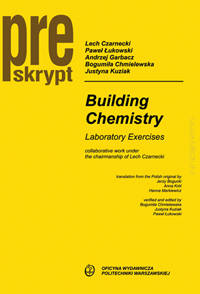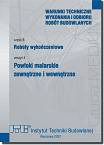Building Chemistry. Laboratory Exercises
- Add feedback:
- Code: 3381
- Manufacturer: Oficyna Wydawnicza Politechniki Warszawskiej
- Autor: Lech Czarnecki, Paweł Łukowski, Andrzej Garbacz, Bogumiła Chmielewska, Justyna Kuziak
-
-
- szt.
- Net Price: 21.90 zł 23.00 zł
Building Chemistry. Laboratory Exercises
rok wydania: 2016
ilość stron: 138
ISBN: 978-83-7814-517-2
Opis
Zadaniem opracowania jest umożliwienie studentom praktycznego zapoznania się z problemami chemii budowlanej w laboratorium. Tematyka ćwiczeń obejmuje oznaczenia związane z określeniem składu jakościowego i ilościowego materiałów budowlanych, zwłaszcza spoiw budowlanych, oraz przebiegiem reakcji chemicznych, w szczególności związanych z procesami korozji i jej skutkami w odniesieniu do betonu żelbetu i metali. Specjalnej uwadze studentów należałoby polecić ćwiczenie komputerowej symulacji hydratacji cementu, stanowiące przykład nowej dziedziny badań – Komputerowej Inżynierii Materiałów (Computation Material Science).
Collaborative work under the chairmanship of Lech Czarnecki
Translation from the Polish original by Jerzy Bogucki, Anna Król and Hanna Markiewicz
Verified and edited by Bogumiła Chmielewska, Justyna Kuziak and Paweł Łukowski
Spis treści
FOREWORD / 6
THE RULES OF WORKING IN THE BUILDING CHEMISTRY LABORATORY / 7
1. Safety and hygiene of work / 7
2. Basic operations conducted in the laboratory and the laboratory equipment / 10
2.1. Conducting of chemical reactions / 10
2.2. Weighing / 11
2.3. Measuring volume / 12
2.4. Titration / 13
2.5. Stirring / 18
2.6. Filtration / 19
2.7. Drying, heating and roasting / 20
3. General rules of preparation of results of tasks / 23
EXERCISES MADE IN BUILDING CHEMISTRY LABORATORY / 24
4. Elements of chemical analysis / 24
Theoretical background / 24
Use of chemical analysis in building engineering / 24
Methods of separating mixtures / 24
Chemical methods of analysis / 25
Detection of cations and anions / 27
Gravimetric methods of quantitative analysis / 28
Volumetric analysis / 29
Use of instrumental methods of chemical analysis / 29
Spectroscopic methods / 30
Electrochemical methods / 33
Thermal analysis / 33
Microscopic analysis / 35
Practical task 1. Identification of chosen cations / 35
Practical task 2. Identification of chosen anions and chemical compounds / 37
Practical task 3. Determining the content of sodium hydroxide in aqueous solution / 38
5. Rate of chemical reactions / 39
Theoretical background / 39
The concept of rate of chemical reaction / 39
Relation of rate of reaction to concentration of reactants / 41
Relation of reaction rate to temperature / 41
Relation of reaction rate to the presence of catalysts / 42
Reactions in multiphase systems / 43
Practical task. Determining the influence of concentration of reagents and temperature on the rate of a chemical reaction / 43
6. Water in building / 46
Theoretical background / 46
Basic properties of water / 46
Influence of water contamination on the quality of concrete / 47
Classification and requirements for the mixing water / 49
Practical task. Evaluation of usefulness of water for building purposes / 51
7. Cement binders / 56
Theoretical background / 56
Production and composition of Portland cement / 56
Portland cement setting and hardening processes / 58
Mineral additives to concrete / 61
Practical task 1. Computer simulation of cement hydration / 62
Practical task 2. Determination of soluble hydroxides in the fluid phase of cement paste / 67
Practical task 3. Determination of concrete contents / 69
8. Lime binders / 73
Theoretical background / 73
Types of lime binders / 73
Lime burning / 73
Lime slaking / 75
Setting and hardening of lime mortar / 75
Hydraulic lime / 75
Requirements for building lime / 76
Practical task 1. Determination of active calcium oxide content in quicklime / 78
Practical task 2. Determination of non-decomposed calcium carbonate content in quicklime / 79
9. Gypsum and anhydrite binders / 82
Theoretical background / 82
Classification of gypsum and anhydrite binders / 82
Production / 82
Setting and hardening of gypsum binders / 84
Modification of gypsum setting rate / 85
Practical task 1. Examination of influence of gypsum roasting conditions on Structure and setting properties of gypsum binders / 87
Practical task 2. Examination of influence of admixtures on setting time of gypsum binders / 89
10. Silicate binders / 92
Theoretical background / 92
Production and chemical constitution of water glass / 92
Water glass setting process / 92
Properties and applications / 94
Practical task. Determination of water glass modulus / 95
11. Resin binders / 97
Theoretical background / 97
Practical task 1. Examining the course of the hardening process of resin binders / 101
12. Chemical modification of concrete / 104
Theoretical background / 104
Classification of chemical modifiers of concrete / 104
Concretes with admixtures / 104
Plasticizing and fluidizing admixtures / 105
Air-entraining admixtures / 108
Admixtures controlling the setting time of a binder / 108
Concretes modified by mineral additives / 109
Polymer-cement concretes / 110
Polymer impregnated concrete / 110
Practical task 1. Assessment of plasticizing properties of concrete admixtures / 111
Practical task 2. Effectiveness assessment of concrete surface hydrophobization / 112
13. Corrosion of construction materials / 114
Theoretical background / 114
Definitions / 114
Concrete corrosion / 114
Metal corrosion / 118
Protection of metals against corrosion / 121
Reinforced concrete corrosion / 122
Concrete carbonation and contamination / 124
Corrosion of other construction materials / 125
Practical task 1. Studying the course of acid corrosion in cement concrete / 125
Practical task 2. Assessment of depth of neutralization and contamination of concrete /127
Practical task 3. Determination of probability of corrosion of the reinforcing steel / 129
APPENDIX
Examples of calculations in building chemistry / 132
rok wydania: 2016
ilość stron: 138
ISBN: 978-83-7814-517-2
Opis
Zadaniem opracowania jest umożliwienie studentom praktycznego zapoznania się z problemami chemii budowlanej w laboratorium. Tematyka ćwiczeń obejmuje oznaczenia związane z określeniem składu jakościowego i ilościowego materiałów budowlanych, zwłaszcza spoiw budowlanych, oraz przebiegiem reakcji chemicznych, w szczególności związanych z procesami korozji i jej skutkami w odniesieniu do betonu żelbetu i metali. Specjalnej uwadze studentów należałoby polecić ćwiczenie komputerowej symulacji hydratacji cementu, stanowiące przykład nowej dziedziny badań – Komputerowej Inżynierii Materiałów (Computation Material Science).
Collaborative work under the chairmanship of Lech Czarnecki
Translation from the Polish original by Jerzy Bogucki, Anna Król and Hanna Markiewicz
Verified and edited by Bogumiła Chmielewska, Justyna Kuziak and Paweł Łukowski
Spis treści
FOREWORD / 6
THE RULES OF WORKING IN THE BUILDING CHEMISTRY LABORATORY / 7
1. Safety and hygiene of work / 7
2. Basic operations conducted in the laboratory and the laboratory equipment / 10
2.1. Conducting of chemical reactions / 10
2.2. Weighing / 11
2.3. Measuring volume / 12
2.4. Titration / 13
2.5. Stirring / 18
2.6. Filtration / 19
2.7. Drying, heating and roasting / 20
3. General rules of preparation of results of tasks / 23
EXERCISES MADE IN BUILDING CHEMISTRY LABORATORY / 24
4. Elements of chemical analysis / 24
Theoretical background / 24
Use of chemical analysis in building engineering / 24
Methods of separating mixtures / 24
Chemical methods of analysis / 25
Detection of cations and anions / 27
Gravimetric methods of quantitative analysis / 28
Volumetric analysis / 29
Use of instrumental methods of chemical analysis / 29
Spectroscopic methods / 30
Electrochemical methods / 33
Thermal analysis / 33
Microscopic analysis / 35
Practical task 1. Identification of chosen cations / 35
Practical task 2. Identification of chosen anions and chemical compounds / 37
Practical task 3. Determining the content of sodium hydroxide in aqueous solution / 38
5. Rate of chemical reactions / 39
Theoretical background / 39
The concept of rate of chemical reaction / 39
Relation of rate of reaction to concentration of reactants / 41
Relation of reaction rate to temperature / 41
Relation of reaction rate to the presence of catalysts / 42
Reactions in multiphase systems / 43
Practical task. Determining the influence of concentration of reagents and temperature on the rate of a chemical reaction / 43
6. Water in building / 46
Theoretical background / 46
Basic properties of water / 46
Influence of water contamination on the quality of concrete / 47
Classification and requirements for the mixing water / 49
Practical task. Evaluation of usefulness of water for building purposes / 51
7. Cement binders / 56
Theoretical background / 56
Production and composition of Portland cement / 56
Portland cement setting and hardening processes / 58
Mineral additives to concrete / 61
Practical task 1. Computer simulation of cement hydration / 62
Practical task 2. Determination of soluble hydroxides in the fluid phase of cement paste / 67
Practical task 3. Determination of concrete contents / 69
8. Lime binders / 73
Theoretical background / 73
Types of lime binders / 73
Lime burning / 73
Lime slaking / 75
Setting and hardening of lime mortar / 75
Hydraulic lime / 75
Requirements for building lime / 76
Practical task 1. Determination of active calcium oxide content in quicklime / 78
Practical task 2. Determination of non-decomposed calcium carbonate content in quicklime / 79
9. Gypsum and anhydrite binders / 82
Theoretical background / 82
Classification of gypsum and anhydrite binders / 82
Production / 82
Setting and hardening of gypsum binders / 84
Modification of gypsum setting rate / 85
Practical task 1. Examination of influence of gypsum roasting conditions on Structure and setting properties of gypsum binders / 87
Practical task 2. Examination of influence of admixtures on setting time of gypsum binders / 89
10. Silicate binders / 92
Theoretical background / 92
Production and chemical constitution of water glass / 92
Water glass setting process / 92
Properties and applications / 94
Practical task. Determination of water glass modulus / 95
11. Resin binders / 97
Theoretical background / 97
Practical task 1. Examining the course of the hardening process of resin binders / 101
12. Chemical modification of concrete / 104
Theoretical background / 104
Classification of chemical modifiers of concrete / 104
Concretes with admixtures / 104
Plasticizing and fluidizing admixtures / 105
Air-entraining admixtures / 108
Admixtures controlling the setting time of a binder / 108
Concretes modified by mineral additives / 109
Polymer-cement concretes / 110
Polymer impregnated concrete / 110
Practical task 1. Assessment of plasticizing properties of concrete admixtures / 111
Practical task 2. Effectiveness assessment of concrete surface hydrophobization / 112
13. Corrosion of construction materials / 114
Theoretical background / 114
Definitions / 114
Concrete corrosion / 114
Metal corrosion / 118
Protection of metals against corrosion / 121
Reinforced concrete corrosion / 122
Concrete carbonation and contamination / 124
Corrosion of other construction materials / 125
Practical task 1. Studying the course of acid corrosion in cement concrete / 125
Practical task 2. Assessment of depth of neutralization and contamination of concrete /127
Practical task 3. Determination of probability of corrosion of the reinforcing steel / 129
APPENDIX
Examples of calculations in building chemistry / 132



